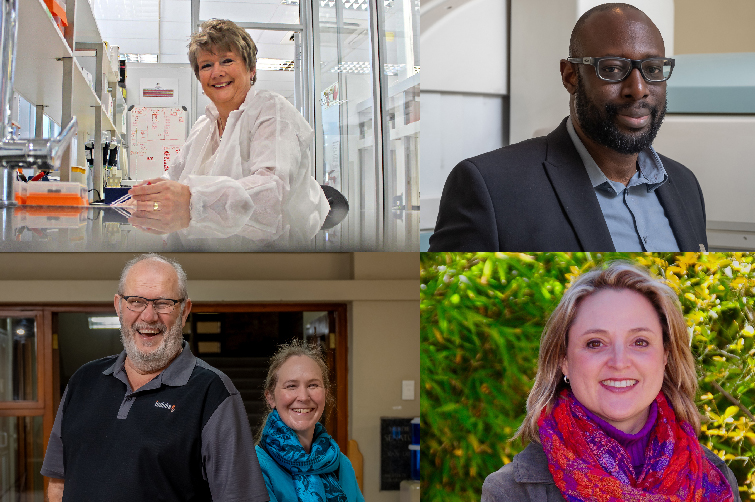02 January 2024
|
Story Leonie Bolleurs
 From top left, moving clockwise: Dr Nerina van der Merwe, Dr Osayande Evbuomwan, Prof Alicia Sherriff, Profs Andreas Roodt and Alice Brink.
From top left, moving clockwise: Dr Nerina van der Merwe, Dr Osayande Evbuomwan, Prof Alicia Sherriff, Profs Andreas Roodt and Alice Brink.
Cancer stands as a prominent contributor to deaths worldwide, with a big impact on families and communities. Prostate cancer is one of the leading causes of mortality in the world. The recent diagnoses of cervical cancer are 10 702 annually, with 5 870 patients passing away. Female breast cancer surpassed lung cancer as the most commonly diagnosed cancer in 2020 (American Cancer Society), representing 11,7% of all cancer cases, making it the fifth leading cause of cancer mortality worldwide. Researchers at the university are doing their part in the fight against cancer.
Treating prostate cancer
In July 2021, Dr Osayande Evbuomwan, Senior Lecturer and Medical Specialist in the Department of Nuclear Medicine, along with a team of university doctors, initiated patient treatment using radioligand therapy (RLT). This targeted nuclear medicine therapy delivers high radiation levels precisely to cancer cells, minimising damage to normal organs and tissue, a benefit not typically provided by conventional therapies.
It was the first time that Lutetium 177 PSMA – a type of PRRT – has been used to treat patients with metastatic castrateresistant prostate cancer (MCRPC) in the Free State, providing hope when standard treatments and conventional therapy are not an option. This treatment generally enhances quality of life, slows disease progression, and extends overall survival, with minimal side effects.
All three patients treated with Lu 177 PSMA so far have completed at least four therapy cycles and tolerated it well. The first two patients, while initially responding well, sadly passed away due to unrelated causes. The third case stands out as the most successful, responding excellently to seven treatment cycle and remaining in good health.
Dr Evbuomwan recently also obtained a license for a more effective therapy, AC 225 PSMA, as an alternative to Lu 177 PSMA.
Precise cervical cancer therapy
Medical personnel at the Universitas Academic Hospital also became the first in Southern Africa to use interstitial brachytherapy as a method for treating cervical cancer. Prof Alicia Sherriff, Head of the Department of Oncology, explains that brachytherapy – a form of internal radiation therapy – places the radiation source near or inside the cancer. “Precise delivery of curative doses to the cancer protects surrounding organs such as the bladder, rectum, and small bowel,” she explains.
Three to five weekly brachytherapy sessions under conscious sedation usually begins after two weeks of daily external beam radiation. On brachytherapy days, external beam radiation is not administered. “The intracavitary brachytherapy applicators are placed within the cervix and uterus and deliver high doses locally, but for surrounding tissue infiltration, additional needles are inserted via the Venezia applicator, delivering high-dose radiation while sparing organs,” says Prof Sherriff.
Their work aligns with the broader goals of the university and its commitment to advancing health care in the region by ensuring the continued growth of their skills and technology, while applying these skills to improve the possibility of disease control, cure or palliation with quality of life.
Familial breast and ovarian cancer testing
Dr Nerina van der Merwe, a principal medical scientist in the Division of Human Genetics, and colleagues are engaged in breast cancer research. They are involved in translational research using new technologies that, once validated as a first-tier diagnostic test, could revolutionise genetic testing for familial breast and ovarian cancer in South Africa when used in conjunction with genetic counselling. This parallel application is ideally suited for primary hospitals and rural clinics, as it will dramatically increase accessibility and uptake of genetic testing in rural areas.
By performing first-tier genetic testing at a community clinic, patients no longer have to be transported to tertiary hospitals for testing, and more patients and related family members who are unaware of a familial predisposition will be reached. “By warning unaffected related individuals about their potential increased risk, we can play a part in the earlier detection or diagnosis of patients, improving their cancer survival rate,” states Dr Van der Merwe.
Patenting cancer research
Prof Andreas Roodt, a retired Distinguished Professor in the Department of Chemistry, and colleagues – particularly Prof Alice Brink and co-worker Prof Roger Alberto from the University of Zurich – have published widely on the chemistry of radiopharmaceutical models. Since the 2000s, the world has introduced the concept of ‘theranostics,’ which involves the use of a single compound for both cancer detection and therapy. “These compounds contain a radioisotope that provides internal radiation for cancer detection (diagnostic) and a second part for treatment,” explains Prof Roodt.
Their research enables the high-yield preparation of compounds containing multiple isotopes often present in very low concentrations. “This allows combining diagnostic isotopes such as technetium-99m (used in >80% of diagnostic patient studies worldwide) with therapeutic radioisotopes, such as rhenium-186 (used for bone cancer therapy), with ease. Many therapeutic radioisotopes do not have good diagnostic radiation; thus, by combining the two types of radioisotopes in one medicine, the oncologist can now clearly see where the therapeutic part is going and apply more effective treatment,” he says.